In the 1950s, men's jackets reflected cultural shifts, embracing both rebellion and sophistication. You'd see black leather bombers defining the greaser image alongside casual Gabardine jackets that offered style and comfort. Overcoats evolved into practical, knee-length designs adorned with bold patterns, while iconic two-tone letterman jackets showcased school pride. Each jacket type, from elegant tuxedos to versatile blazers, catered to varying occasions and individual tastes. Sizes were tailored for diverse body types, emphasizing that fit mattered. Understanding these styles provides insight into men's fashion trends of the time and influences today's styles, revealing even more about this vibrant decade.
Iconic Jacket Styles of the 1950s
In the vibrant landscape of 1950s fashion, men's jackets played a pivotal role in shaping youth culture and identity. The black leather bomber jacket emerged as a defining symbol of greaser culture, reflecting a rebellious spirit that resonated with young men. Popularized by films like "Grease," this jacket wasn't just clothing; it was a statement of defiance and individuality, often sought after by collectors for its iconic status in vintage clothing vintage clothing identification.
In contrast, the lightweight Gabardine jacket offered a more polished look, featuring ribbed cuffs that appealed to the style-conscious youth. Its versatility made it a staple in many wardrobes, effortlessly shifting from casual outings to social gatherings.
As the decade progressed, short jackets like suede and leather bombers gained traction, emphasizing a rugged aesthetic that appealed to the adventurous spirit of the youth. Other notable styles included two-tone letterman jackets, which showcased school pride, often adorned with vibrant colors and logos. Meanwhile, practical yet stylish options like belted bush jackets and plaid mackinaws reflected the era's focus on functional outerwear. Each of these iconic styles contributed uniquely to the rich tapestry of 1950s men's fashion, shaping how young men expressed their identities.
Casual Jacket Types
Casual jackets in the 1950s presented a blend of style and functionality, catering to the evolving tastes of young men seeking comfort without sacrificing aesthetics. This era welcomed a variety of casual jacket types, each reflecting the dynamic culture of the time.
- Leather Motorcycle Jackets: These rugged pieces became synonymous with greaser culture, heavily associated with icons like Marlon Brando and James Dean. They exuded a rebellious spirit, appealing to young men enthusiastic to assert their identity.
- Harrington Jackets: Lightweight and stylish, Harrington jackets featured elastic cuffs and were available in a range of colors. They provided a versatile option for casual outings, effortlessly bridging the gap between relaxed and refined.
- Suede and Leather Bomber Jackets: Symbolizing a rugged aesthetic, these jackets offered warmth and style, making them a staple for adventurous youths.
- Cotton Jackets: Ideal for warmer weather, cotton jackets emerged as a practical choice, combining comfort with a laid-back look.
These casual jacket types not only defined the fashion landscape of the 1950s but also laid the groundwork for future styles that continue to resonate today.
Overcoat Trends
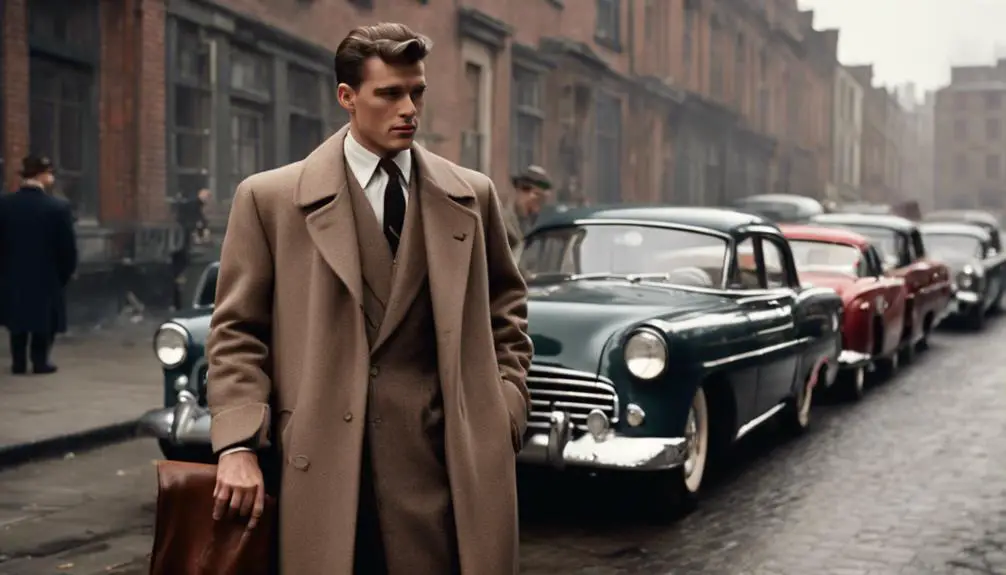
As the focus on casual jackets flourished in the 1950s, the demand for overcoats also evolved, reflecting a shift in men's fashion priorities. The overcoat shifted from longer styles to more practical knee-length designs, catering to men's need for both style and functionality. This change allowed for easier movement and versatility while still providing warmth.
Bold patterns and textured wool fabrics became the hallmark of vintage overcoats during this time, showcasing individuality and a departure from conservative styles. Among the popular choices was the Crombie coat, known for its tailored silhouette that not only flattered the figure but also kept wearers warm in colder weather.
Additionally, double-breasted raincoats emerged as a lighter alternative, appealing to those seeking a combination of elegance and practicality. The distinctive detailing in these overcoats, such as exaggerated shoulder-to-waist ratios, contributed to their iconic look, making them a staple in men's wardrobes. Overall, the overcoat trends of the 1950s encapsulated a blend of modernity and tradition, paving the way for the evolution of men's outerwear in subsequent decades.
Vintage Vs. Modern Comparisons
There's a fascinating contrast between vintage jackets from the 1950s and their modern counterparts, highlighting how fashion evolves over time. While vintage jackets like the black leather bomber and gabardine styles showcase unique aesthetics, modern reproductions focus on fit and contemporary materials. Understanding the significance of vintage tag identification can also enhance your appreciation of these garments. Here are some key differences:
- Pricing: Vintage jackets can range from $12 for affordable pieces to over $3,000 for high-end options, while modern jackets often have a more standardized pricing structure.
- Condition: Vintage jackets come with varying conditions, rated from "good" to "poor," impacting their value, whereas modern jackets arrive in pristine condition.
- Distinctive Details: Vintage jackets boast original branding and historical features, giving them character that modern designs may lack, as they prioritize functionality and comfort.
- Audience Appeal: Collectors gravitate toward vintage jackets for their authenticity and nostalgia, while modern styles attract a broader audience by blending vintage aesthetics with current trends.
Understanding these differences can help you appreciate the unique charm of vintage jackets in men's fashion while recognizing the practicality of modern reproductions.
Notable Jacket Options
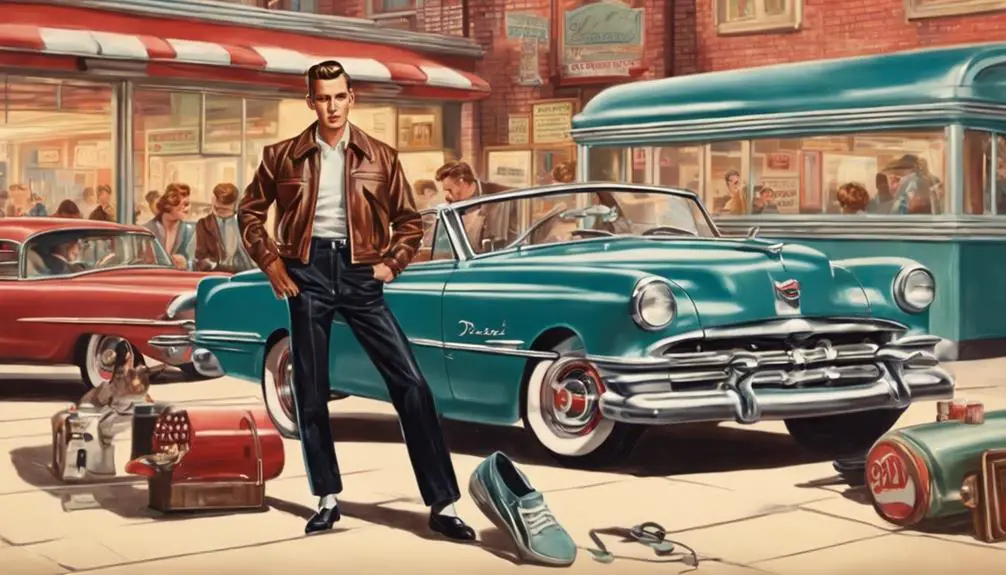
Exploring notable jacket options from the 1950s reveals a diverse array of styles that cater to various tastes and occasions. One standout is the Vintage 1950s Gabardine Ricky Jacket, priced at $187.00, featuring flap pockets and available in larger sizes like XL and XXL. This coat blends practicality with classic style, making it a versatile choice for many men.
Another option is the Vintage 50s Satin Bowlers Jacket, listed at $300.00 with "or Best Offer" pricing. This jacket appeals to both collectors and casual wearers due to its unique aesthetic and collectible nature. For those seeking something more distinctive, the Vintage 1950s Korean Souvenir Jacket offers intricate designs for $235.00, showcasing craftsmanship and cultural flair.
If you're after negotiation flexibility, consider the Vintage 50s Chain Stitch M.C. Jacket, also at $300.00 with "or Best Offer" pricing. Finally, the Vintage 50s Reversible Gabardine Ricky Jacket, similarly priced, emphasizes versatility, allowing you to switch styles while maintaining comfort. Each of these options highlights the innovative spirit of men's jackets during this iconic decade.
Jacket Categories
In the 1950s, men's jackets were categorized into distinct styles that not only reflected the fashion trends of the time but also catered to various social contexts and personal expressions. Each category served a specific purpose, showcasing individuality and societal norms.
Here are four prominent jacket categories from the era:
- Overcoats: These long coats shifted to knee-length, prioritizing practicality and warmth. Made from bold patterned fabrics, they became essential for colder climates and formal outings.
- Tuxedo Jackets: Offering a touch of elegance, these jackets featured shawl collars and were reserved for special occasions. They highlighted the era's affinity for sophistication and formal attire.
- Blazers: Available in various styles, from classic cuts to mod designs, blazers were versatile enough for both formal and casual settings, crafted from wool or cotton blends.
- Casual Jackets: This category embraced styles like Rockabilly and denim, reflecting the youthful spirit of the 1950s. These jackets catered to everyday wear, allowing for personal expression amid a backdrop of cultural change.
These categories not only shaped men's wardrobes but also highlighted the evolving fashion landscape of the decade.
Size Availability
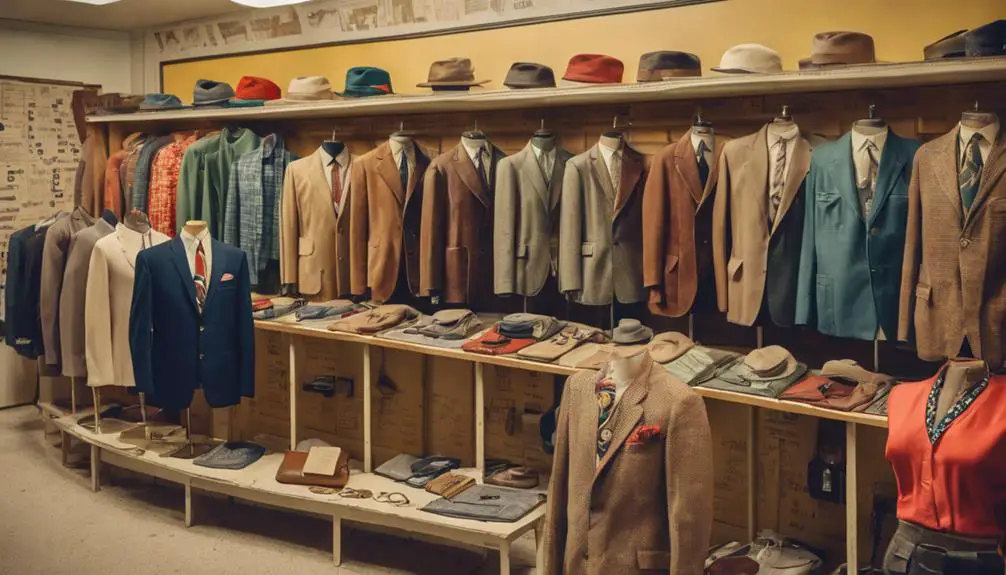
During the 1950s, men's jackets were designed with a keen awareness of size availability, guaranteeing that a wide range of body types could find a fitting option. The diversity of jacket sizes ranged from extra small to larger sizes, with chest measurements spanning from 25 to 46 inches. This variety reflected a commitment to accommodating different physiques, allowing you to find a jacket that truly fits.
Sleeve lengths were equally flexible, varying from 29.5 to 37 inches, which meant you could choose a jacket that suited your arm length comfortably. While common medium sizes dominated the market, the availability of sizes up to 2XL and beyond broadened the appeal of these jackets, making them accessible to a larger audience.
Whether you were looking for a classic wool car jacket or a more casual option, the emphasis on size availability guaranteed that every jacket man could find something suitable. This focus on fit not only enhanced your comfort but also allowed you to express your personal style, making the 1950s a pivotal time in the evolution of men's outerwear.
Condition Ratings
While evaluating vintage men's jackets from the 1950s, understanding condition ratings is essential for making informed purchasing decisions. These ratings help you assess the quality and longevity of a jacket, ultimately influencing its value in the vintage market. Here are the primary condition categories you'll encounter:
- Good Condition: Minimal wear and tear, with all original features intact. These jackets are typically the most desirable.
- Fair Condition: Noticeable signs of wear, such as minor stains or scuffs. While still wearable, you might consider them for casual use.
- Poor Condition: Significant wear and damage. These jackets may require repairs and are often less desirable unless you're a collector seeking specific pieces.
- Restoration Potential: Jackets that need substantial work but have unique features or history can be appealing to dedicated collectors.
Pricing Overview
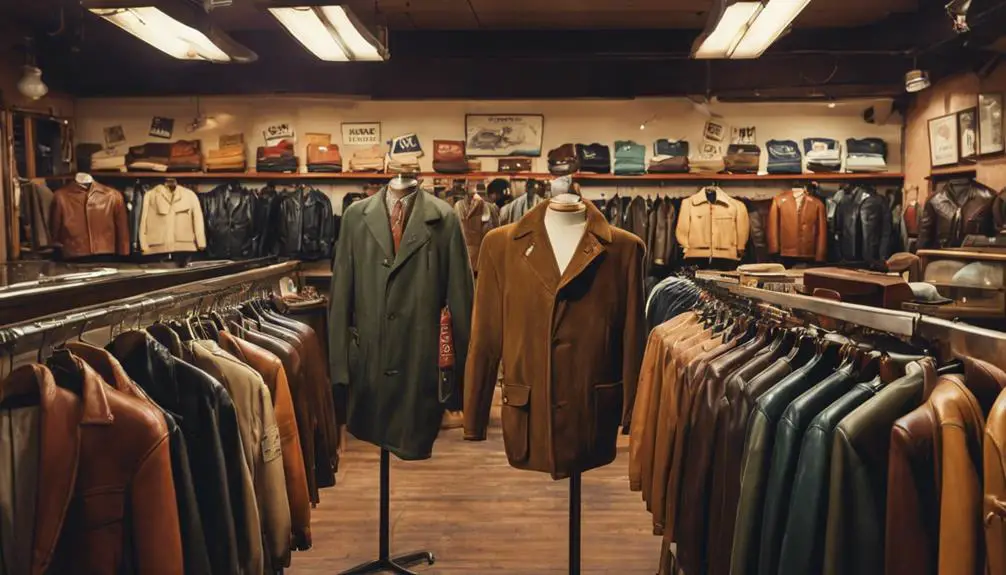
Vintage men's jackets from the 1950s present a fascinating spectrum of pricing influenced by factors like condition, rarity, and brand identity. If you're delving into the market, you'll notice high-end vintage options, such as the Vintage Levi's Big E 507 Jacket, can soar up to $3,200, while the LEVIS Type 2 II 507XX reaches around $3,500. On the other hand, there are more budget-friendly choices, like the VTG Late 1940s Gabardine Ricky Jacket for just $187, or the Vintage 50s Chain Stitch M.C. Jacket priced at $300 with "or Best Offer" options.
When considering your purchase, keep in mind the shipping costs, which typically range from $6 to $19.55 for high-end jackets, while affordable ones hover around $12 to $18.50. The condition of these jackets plays a vital role in their pricing; pieces in good condition will command higher prices than those in fair or poor shape. Rarity and unique features also greatly affect pricing, with some items available for as low as $12, showcasing the vast landscape of vintage leather jackets you can explore.
Frequently Asked Questions
What Jackets Were Popular in the 50s?
In the 50s, you'd notice black leather bombers, lightweight gabardine styles, and two-tone letterman jackets dominating the scene. Suede motorcycle jackets also gained traction, reflecting a balance between comfort, rebellion, and youthful school pride.
What Type of Clothing Was Popular for Men in the 1950s?
In the 1950s, you'd notice men favoring tailored suits, casual button-down shirts, and fitted trousers. Fabrics like wool and cotton dominated, offering both style and comfort, reflecting a blend of sophistication and youthful rebellion in fashion.
Did Men Wear Leather Jackets in the 50s?
Yes, you'll find that men embraced leather jackets in the 50s, especially iconic styles like bombers and motorcycle jackets. These pieces symbolized rebellion, influenced by pop culture and youthful defiance prevalent during that era.
Did Men Wear Jean Jackets in the 50s?
Yes, you'll find that men embraced jean jackets in the 50s, often layering them over t-shirts. These versatile pieces reflected youthful rebellion, showcasing a rugged yet stylish aesthetic that resonated with the burgeoning rock and roll culture.
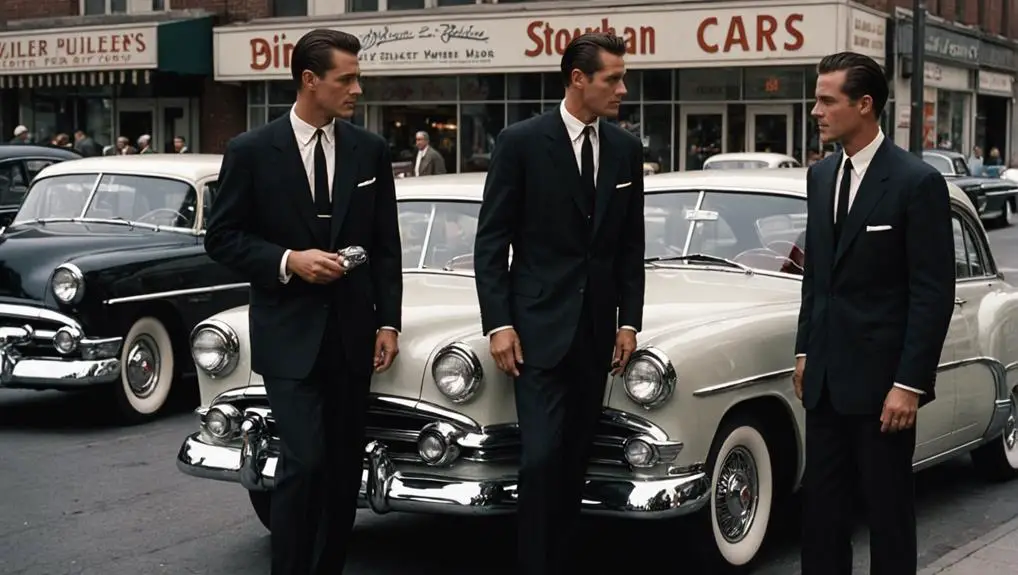

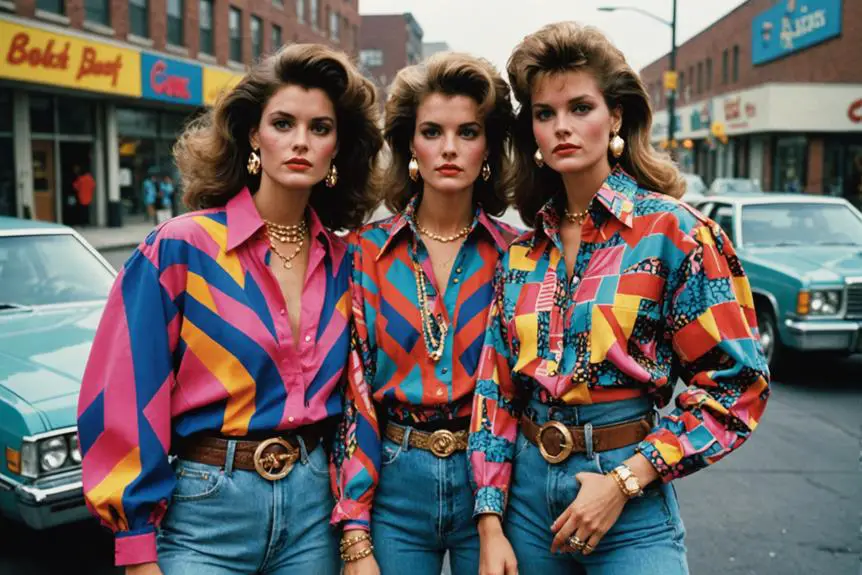
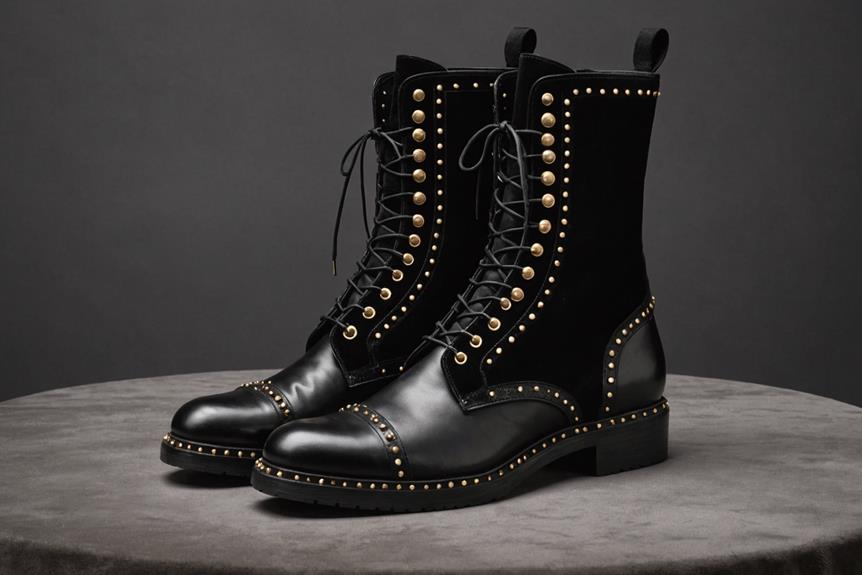

I am not really good with English but I get hold this rattling easygoing to translate.